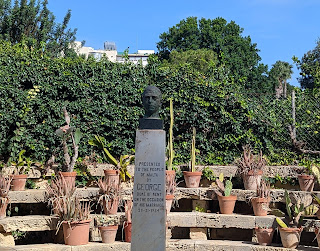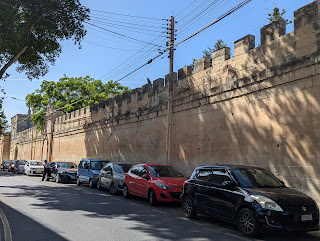Malta's main road through the center of the island from Mosta to the capital city of Valletta passed through Birkirkara, one of the country's largest population centers, with about 23,000 inhabitants. Just outside of Birkirara was an upscale residential development area known as the Three Villages, centered on the medieval settlements of Attard, Balzan, and Lija.
During Britain's rule of the island nation, San Anton Palace and Gardens in Attard became the official residence of the British Governor. The palace was originally built in the early 17th century as a country villa for Antoine de Paule, a knight of the Order of St. John. Part of the gardens were opened to the public in 1882, and the palace became the President's official residence when Malta became a republic in 1974. The lovely Eagle Fountain, just inside the main gate, dates to the 1620s.
The turtle looked like it was part of the sculpture until it moved!
I thought of you, Sarah, when I noticed the stately California fan palm, as you were in California then. George, Duke of Kent, presented the tree to the people of Malta when he married on November 29th, 1934.
We were surprised that visitors were allowed to walk right up to the palace's front doors, and that we witnessed no security. Perhaps the president was away from the palace that day.
The Japanese sculpture was a gift from the Cherry Blossom Festival and the Copper Producers' Association in 1970.
We so enjoyed wandering through the groves of citrus and avocado in the relaxing walled gardens.
The village of Attard had one grand mansion after another. I don't mind revealing we ogled them as we strolled by!
We weren't able to enter the nearby Villa Bologna, a Baroque, 16th-century mansion, but I bought some marvelous Ceramika Maltija handmade pottery made from traditional designs from their shop next door.
Atmospheric Attard's medieval lanes:
Tiny Attard was also home to the Santa Maria Church.
I can't claim to be a linguist, but I could determine from the Malti sign that the next building was the Pope Paul II Parochial Center!
St. Mary's Club was built in 1912. As you likely recall, most Maltese towns had their own band clubs.
We also felt like we walked back in time as we strolled through neighboring Lija. There was hardly any traffic or people wandering down the narrow lanes.
Near the villages was the unused Ta'Qali Airfield, one of the most important and, therefore, one of the busiest during World War II. Because of the villages' proximity to the airfield, accidents occurred. It was common practice for the airplanes stationed at Ta'Qail to be ordered to fly and engage the approaching enemy. At the height of the war over Malta, in 1942, a Spitfire piloted by a young Canadian was engaged in a dogfight, and the pilot was killed. The plane continued to fly until it crashed over this inhabited area in Lija, where a Maltese serviceman was riding his bicycle after picking up his cigarette ration. The experience was, unfortunately, common during the war. The spot where the plane hit the corner of the wall was still visible.
There were more fun doorknockers to admire in each of the villages. This one was in Lija.
We thought we ended our meanderings in Lija at the village's St. Peter's Church. The earliest records of a church dedicated to St. Peter in Lija date to the 16th century, with a church already erected in 1575 during a visit by the Papal Delegate. Over the ensuing centuries, altars were removed, and the church was closed more than once because no one took responsibility for its furnishings or financial support. The present Baroque-style church was constructed in the 18th century, thanks to the Knights' resident engineer. Above the main doorway, the round window was framed by a sculpted papal insignia. The church and a small house attached to it were handed over to the Dominican nuns in 1916, who served the sick and needy. They still administer the church's religious functions - the first I'd ever heard of for any Catholic church anywhere!
I could hardly believe that, just one block away, was the village's mammoth Parish Church, also known as the Church of the Transfiguration!
Just down the street, the Lija Belvedere Tower was built in 1857 as a folly within the gardens of Villa Gourgion, a 17th-century villa. In the 1950s, part of the villa's garden was destroyed to make way for Transfiguration Avenue, and the belvedere was retained as a roundabout.
Lija was so small that we could stand in one spot and, while turning around, view both churches and the Belvedere tower!
Our last stop in Malta was the Pembroke Heritage Project, just twenty minutes away on the island's north shore. The project consisted of a 2.5km walking and cycling trail on pathways used by British forces to patrol the area during the war. The trail was envisioned to highlight the beauty of Malta's rocky shorelines.
The project sounded intriguing, but the reality was less than ideal. The paths were uneven and of poor quality, and almost nonexistent when we reached the shore. Sadly, it appeared the project's best days had been long ago, and a serious investment of cash would be necessary to bring it up to snuff. The knowledge that the Malta Armed Forces still used the area was also disquieting. However, on the bright side, the views along the Mediterranean shoreline were exquisite.
British gun emplacements on the shoreline:
I'll never tire of gazing at the gorgeous Mediterranean Sea!
It was strange seeing this selfie I took last October, as it's been my laptop screensaver ever since. Time for a change, methinks!
That night, on the plane en route to Tunisia, we had our last views of the Mosta Dome and the Marfa Peninsula with Gozo and Comino in the distance.
Steven and I had an exceptional time touring pretty much all of Malta, a country that will rank among the top in the more than 100 countries and numerous territories Steven and I have been lucky enough to explore. We loved its rich archaeological history, its vibrant cities of Valletta, Rabat, and Mdina, the dropdead gorgeous views of the Grand Harbor, the country's small towns and villages with their often grandiose churches, the oh-so-easy roads that were in universally great shape, the medieval history with the Knights of the Order of St. John, some great meals, the delightful island of Gozo, the unwavering strength of the Maltese who put up with unimaginable hardships during World War II, and little things like the grand balconies and adorable doorknockers in town after town.
However, another country, Tunisia, awaited our exploration, and we were excited!
Next post: My impressions of Malta, if I haven't given away the store already!
Posted on April 8th, 2025, from an almost hot Denver day with temperatures due to climb to the mid-80s over the weekend. That doesn't mean, though, we won't get hit by more snow! Please take care of yourself and your loved ones.














































So very interesting.
ReplyDeleteThanks, Lynne - glad you enjoyed it!
ReplyDeleteEverything seems so pristine, especially set against the glorious blue skies. xo Lina ox
ReplyDeleteI don't know why I didn't think about it when we were in Malta, but the skies were a gorgeous blue, each and every day, Lina!
DeleteThe Mosta Dome is very beautiful and amazing from the ground or air. JDK
ReplyDeleteI couldn't agree with you more, Janina - it wZ stunning from every angle.
Delete